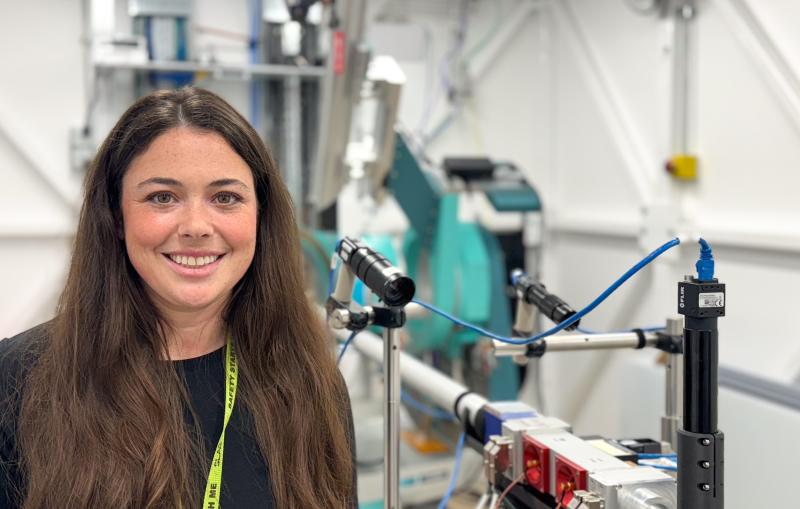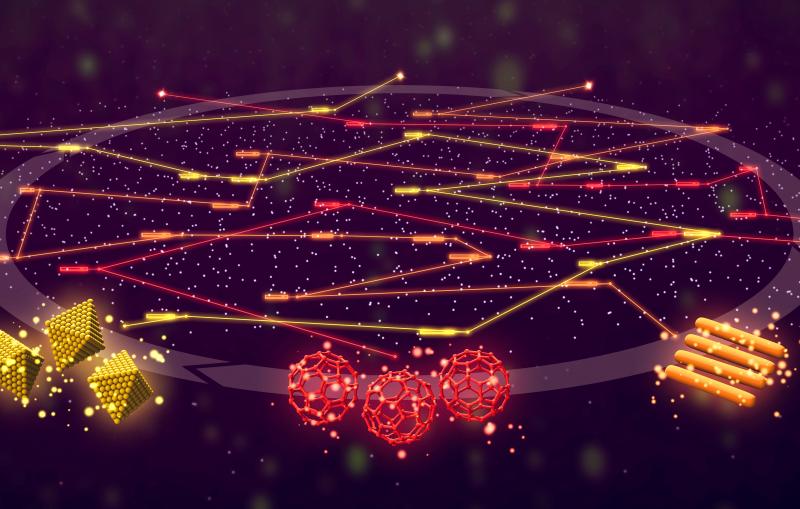Angel Garcia-Esparza wins 2023 Spicer Young Investigator Award for studying catalysts in action
Garcia-Esparza’s research offers unique insights into catalysts relevant to renewable energy generation and emerging materials for microelectronics.
By Chris Patrick
Analyzing a catalyst while it does its job in a chemical reaction is no easy task. Instead, researchers often rely on “post-mortem” analyses, comparing the catalyst before and after a reaction and piecing together what happened to it.
Angel Garcia-Esparza, however, uses X-rays produced by the Stanford Synchrotron Radiation Lightsource (SSRL) at the Department of Energy’s SLAC National Accelerator Laboratory to monitor how catalysts and energy materials behave during chemical reactions in different environments, such as in renewable energy conversion technologies and the development of next-generation microelectronics.
His work earned him the SSRL’s 2023 Spicer Young Investigator Award. He is pleasantly surprised to join the company of previous winners.
“I read the list of the previous winners, and these are amazing, hardworking people. I am familiar with the quality of science that’s done at SLAC. For SSRL-SLAC to recognize our work is just an honor,” said Garcia-Esparza, a project scientist at SSRL.
But he’s also quick to point out that his work, which involves carrying out complicated experiments at the SSRL end-stations and developing theoretical frameworks to interpret unprecedented data, is only possible with the close collaboration of his community at SLAC.
“It’s like a symphony,” he said. “Everybody is helping each other and doing their part to make the whole thing work in harmony. My name goes on the award, but it is thanks to SLAC, and to our group at SSRL in particular.”
Angel Garcia-Esparza
(Jacqueline Orrell/SLAC National Accelerator Laboratory)

“X-ray vision” for catalytic degradation
Garcia-Esparza is especially interested in developing and characterizing catalysts for renewable energy. Electrocatalysts in particular assist in a chemical reaction known as water splitting, wherein electricity produced with a form of renewable energy, be it sun, wind, or water, is used to break water molecules into hydrogen and oxygen. The hydrogen can then be stored and used as a fossil-fuel-free form of energy.
“Electrocatalysts are key to the development of a renewable energy economy in not just the U.S., but the world,” Garcia-Esparza said.
Platinum is one such electrocatalyst. This catalyst is also used in fuel cell vehicles. For either of these applications, researchers need platinum to remain stable for long periods of time no matter the conditions.
While platinum’s catalytic performance under acidic conditions has been thoroughly documented, studies under alkaline conditions were far less comprehensive. Using X-ray absorption spectroscopy at SSRL, Garcia-Esparza and his colleagues showed how platinum degrades faster in alkaline conditions.
“He addressed a knowledge gap in understanding the degradation mechanisms in acidic versus basic environments,” wrote Dimosthenis Sokaras in Garcia-Esparza’s nominating letter. Sokaras, a senior scientist at SSRL, nominated Garcia-Esparza for “his dedication, innovative approach and research.”
His findings will help researchers design more efficient, durable catalysts for energy conversion, but extend beyond platinum.
Big innovation for a thin material
Garcia-Esparza is also being recognized for his study of the degradation of a different material, two-dimensional molybdenum disulfide, as part of a collaborative research project between Xiaolin Zheng of Stanford University and Sokaras that was funded by the Precourt Institute of Energy. Using this atomically thin material would allow microelectronics to surpass current size limitations, but there simply isn’t enough substance in a single layer of 2D molybdenum disulfide sample to probe it with current X-ray methods.
To overcome this, Garcia-Esparza helped develop and optimize a new instrument that was able to measure this super thin, or diluted, material with X-ray absorption spectroscopy under reaction conditions for the first time.
“We were able to capture the beautiful spectra of these atomically thin materials, which was a very difficult challenge by itself,” he said about this breakthrough.
Once Garcia-Esparza and his colleagues proved they could obtain the spectra of a single layer of 2D molybdenum disulfide, they determined how the addition of oxygen or hydrogen gas affected the samples at different temperatures. At even low levels of oxygen, Garcia-Esparza found the material oxidized faster than expected due to traces of oxide species present in the sample. Removing the impurities from the molybdenum disulfide beforehand yielded more stable samples at higher temperature, suggesting future devices based on this material must be free of oxide to prevent swift degradation in microelectronics.
Garcia-Esparza also showed how hydrogen gas removes sulfur atoms from the 2D molybdenum disulfide, effectively tuning its electronic properties.
“We elucidated the formation mechanism of the sulfur vacancy in molybdenum disulfide and described its atomic structural identity, which is key to optimize their application in electronic, optical and catalytic systems” Garcia-Esparza said.
He also reported the electrochemical characterization of these sulfur vacancy sites, which are active catalytic sites for hydrogen production from water splitting, in ACS Nano and Advanced Science.
“Dr. Angel T. Garcia-Esparza has continuously elevated the unique advantages of advanced X-ray spectroscopy at SSRL for conducting operando characterizations of energy materials under real reaction conditions,” wrote Sokaras, who also made note of Garcia-Esparza’s collaborative spirit and mentoring efforts within the SSRL community.
The Spicer Award will be presented to Garcia-Esparza during the 2023 SSRL/LCLS Annual Users' Meeting and Workshops at SLAC, which will be held September 25–29. The award is named in honor of the late William Spicer, who co-founded what would become SSRL, and his wife Diane.
SSRL is a DOE Office of Science user facility.
For questions or comments, contact the SLAC Office of Communications at communications@slac.stanford.edu.
About SLAC
SLAC National Accelerator Laboratory explores how the universe works at the biggest, smallest and fastest scales and invents powerful tools used by researchers around the globe. As world leaders in ultrafast science and bold explorers of the physics of the universe, we forge new ground in understanding our origins and building a healthier and more sustainable future. Our discovery and innovation help develop new materials and chemical processes and open unprecedented views of the cosmos and life’s most delicate machinery. Building on more than 60 years of visionary research, we help shape the future by advancing areas such as quantum technology, scientific computing and the development of next-generation accelerators.
SLAC is operated by Stanford University for the U.S. Department of Energy’s Office of Science. The Office of Science is the single largest supporter of basic research in the physical sciences in the United States and is working to address some of the most pressing challenges of our time.





